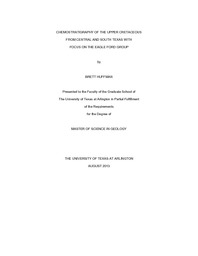
ATTENTION: The works hosted here are being migrated to a new repository that will consolidate resources, improve discoverability, and better show UTA's research impact on the global community. We will update authors as the migration progresses. Please see MavMatrix for more information.
Show simple item record
| dc.contributor.author | Huffman, Brett | en_US |
| dc.date.accessioned | 2013-10-22T23:59:10Z | |
| dc.date.available | 2013-10-22T23:59:10Z | |
| dc.date.issued | 2013-10-22 | |
| dc.date.submitted | January 2013 | en_US |
| dc.identifier.other | DISS-12303 | en_US |
| dc.identifier.uri | http://hdl.handle.net/10106/23914 | |
| dc.description.abstract | The fine-grained organic-rich rocks of the Eagle Ford (Cenomanian-Turonian) were deposited during the Upper Cretaceous in the shallow waters of the Western Interior Seaway. Five drill cores recovered from two counties, four from Travis County, Texas and one from Frio County, Texas, have been scanned from between two foot and half foot intervals with a hand-held energy-dispersive x-ray fluorescence (HH-ED-XRF) spectrometer to acquire major (e.g. Ca, Si, Al) and trace (e.g. Mo, V, Ni) element data for quantitative analysis. Additionally, gamma ray logs have been analyzed for two of the cores. Major element geochemistry indicates the Eagle Ford deposited in South Texas is different from the Eagle Ford deposited in Central Texas. South Texas Eagle Ford is much more Ca (carbonate) rich, with a noticeably lower Al (clay) content. South Texas and Central Texas Eagle Ford both have low Si (quartz) content relative to the Al and Ca content, indicating a negligible siliciclastic contribution during deposition. Trace element analysis reveals the redox conditions of the bottom waters during deposition. Mn -- an element which becomes mobile and may be removed from an open system in reducing conditions -- levels are much higher in the Austin Chalk and Buda with notably lower values in the Eagle Ford in both Central Texas and South Texas. Mo, an element which tends to bind with organic matter or sulfides during reducing conditions, is notably higher in the Eagle Ford of both South Texas and Central Texas. The correlation of decreased Mn levels and increased Mo levels suggests that the Eagle Ford was deposited in reducing conditions in an open system capable of removing mobilized Mn. Geochemical analysis of major and trace elements obtained from ED-XRF may be used in the petroleum industry in concert with XRD, electric logs, and standard core analysis to give a more complete picture of the depositional environment, clay type and volume, geophysical rock properties, and areal extent of a potential unconventional shale reservoir for hydrocarbon extraction. XRF data offers insight about the rocks, leading to improved understanding of the depositional environment and chemical makeup. Applying these technologies to the Eagle Ford helps unlock the potential of this significant hydrocarbon source and reservoir. | en_US |
| dc.description.sponsorship | Rowe, Harold | en_US |
| dc.language.iso | en | en_US |
| dc.publisher | Geology | en_US |
| dc.title | Chemostratigraphy Of The Upper Cretaceous From Central And South Texas With Focus On The Eagle Ford Group | en_US |
| dc.type | M.S. | en_US |
| dc.contributor.committeeChair | Rowe, Harold | en_US |
| dc.degree.department | Geology | en_US |
| dc.degree.discipline | Geology | en_US |
| dc.degree.grantor | University of Texas at Arlington | en_US |
| dc.degree.level | masters | en_US |
| dc.degree.name | M.S. | en_US |
Files in this item
- Name:
- Huffman_uta_2502M_12303.pdf
- Size:
- 2.992Mb
- Format:
- PDF
This item appears in the following Collection(s)
Show simple item record


